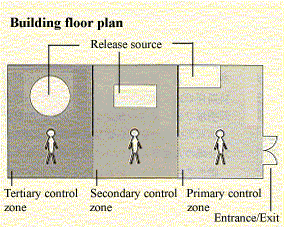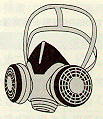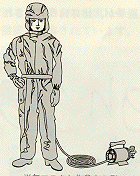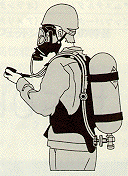Current Trends
in Chemical Substance Management
-- MSDS and the Dioxin Problem --Chemical Substance
Investigation Division
Industrial Safety and Health Department
Ministry of Labour
This paper was printed in "SANGYO-TO-HOKEN(industry and health) Vol.52" published by Shigematsu works co.,ltd. in Japanese.
JICOSH was allowed by courtesy of Shigematsu works co.,ltd. to use this paper on its web. (translated by JICOSH)
1. MSDS
(1) Introduction
Material safety data sheets
(MSDS) are documents that list chemical substance names, components, chemical properties, hazards, and cautions on storing and handling. MSDS are issued to the receivers of chemical substances by people who transfer and supply such substances. This information ensures that employers,
employees, and other related parties that handle chemical substances will
be familiar with the associated hazards. (Refer to the example
in Reference 1.)
Based on the purport of
the Chemicals Convention (No. 170) that the International Labour
Office (ILO) adopted in 1990 along with its accompanying Recommendation
No. 177, the Ministry of Labour officially released in 1992 its
Guidelines Concerning Indication of Hazards of Chemical Substances
as a Ministry of Labour Bulletin providing instruction on the creation
and issuing of MSDS.
The Ministry of International
Trade and Industry (MITI) and the Ministry of Health and Welfare
also provide instruction on the creation and issuing of MSDS, but
they do so from different perspectives than that of the Ministry of Labour.
(2) Industrial Safety
and Health Law
The Industrial Safety and
Health Law has been revised, and matters concerning MSDS have
been prescribed anew. The revision was an attempt to
further complete chemical substance management measures in addition
to past policies. The reason for the revision is that industrial
accidents are still occurring in large numbers, and in order
to prevent them, it is critical to reliably communicate information
including chemical substance hazards in the workplace, and then
based on this information, to establish countermeasures for appropriately
preventing health problems in the workplace.
The revision mainly dealt
with legislating that those who transfer and supply chemical
substances that may potentially threaten employee health must issue
MSDS to those who receive such chemicals. It also prescribed
that the Minister of Labour shall publish guidelines concerning
measures that employers must devise in order to prevent threats
to employee health from chemical substances and other harmful materials,
and that MSDS must be made widely available to employees who handle
chemical substances by always having them posted in easily visible
locations in the workplace.
Concerning the specific
scope of chemical substances and other materials for which MSDS
must be issued, items not covered by the manufacturing approval
in paragraph 1, provision 56 of the Industrial Safety and Health
Law are to be stipulated in a separate government ordinance. Future
plans call for selecting chemical substances from among those
that are subject to the recommendations of the Japanese Association
of Industrial Health and the American Conference of Governmental
Industrial Hygienists, Inc. (ACGIH). Note that the enforcement
of the law revision is scheduled to begin on April 1, 2000.
2. The Dioxin Problem
(1) Introduction
Dioxin is a general term
for the 210 isomers of polychlorinated dibenzodioxin (Figure
1) and polychlorinated dibenzofuran (Figure
2). Dioxins differ from the chemical substances normally
manufactured and used in the chemical industry in that they are
not created intentionally. Rather, they are generated as by-products
when other substances are combined or when waste material is
incinerated.
In Japan, mass media reports
on the detection of dioxins in the ash and grounds around waste
incineration facilities have triggered fears of environmental
pollution and health risks associated with such chemicals. In
light of such fears, the Ministry of Labour is also studying
and researching dioxins at waste incineration facilities and
pursuing countermeasures that prevent employee exposure.
The government recognizes
that the dioxin problem is an issue that must be dealt with more
forcefully through Cabinet meetings for the purpose of protecting
the people health and preserving the environment for the
future. Based on this recognition, the government initiated the
Extraordinary Cabinet Meeting on Dioxin Countermeasures, and
on March 30 of this year, it reached a decision on the Basic
Policy on Promoting Dioxin Countermeasures. In this basic policy,
the government extols the promotion of measures such as those
that reconsider the tolerable daily intake (TDI), along with
those that promote measures for reducing the dioxin discharge,
improve the inspection system concerning dioxins, and attempt
to grasp the actual effects on health and the environment. To support the government, the
Ministry of Labour has indicated that it will promote measures
for setting up an industrial health management system, as well
as measuring working environments, improving working environments,
and promoting utilization of the appropriate protective equipment.
It also indicated that it will attempt to grasp the health conditions
of employees and the actual state of working environments.
 |
 |
Figure 1: Polychlorinated
Dibenzodioxin |
Figure 2: Polychlorinated
Dibenzofuran |
(2) Health Hazards of
Dioxin
There have been reports
on dioxin toxicity to humans that have acknowledged the occurrence
of chloracne in groups exposed to high concentrations as a result
of accidents at agricultural chemical manufacturing plants in
Italy and Germany. Other reports have acknowledged through long-term
epidemiological studies that frequent increases in cancer occurred
in groups exposed to extremely high concentration when compared
against groups that were not exposed. Furthermore, dioxin
effects as a substance that disturbs endocrines have been in the
spotlight in recent years, but there are many unknown details
regarding whether there are any direct effects on human health,
and if there are, to what degree. At the present time, only 2,
3, 7, 8-tetrachlorodibenzo-p-dioxins (2, 3, 7, 8-TCDD) have been
evaluated by the International Agency for Research on Cancer
(IARC) as substances that cause human cancer.
Currently, the World Health
Organization (WHO) is advocating a change in the tolerable daily
intake (TDI) from the present 10 pg per 1 kg of bodyweight to
1 to 4 pg. As a result, the Ministry of Health and Welfare and
the Environment Agency are considering revisions to the TDI in
Japan.
(3) Investigative Research
at the Ministry of Labour
In 1997, the Ministry of
Labour established its Investigative Research Committee on Preventing
Health Problems Due to Chemical Substances in the Waste Processing
Business through which it is conducting investigative research
on dioxins at waste incineration facilitates. Also in 1997, the
Ministry measured the dioxin concentrations in working environments,
incineration ash, and airborne ash at a general waste incineration
facility and at an industrial waste incineration facility. This
data was used for the Ministry Research on Dioxins in Working
Environments.
In 1998, the Ministry of
Health and Welfare released a report stating that high concentrations
of dioxins were detected in the soil after investigating the
Toyono-gun Beautification Center. As a result, the Ministry of
Labour began emergency studies of the facts behind dioxin exposure
and the health status of employees engaged in work at that facility
and commissioned the Japan Industrial Safety and Health Association
to conduct investigative research.
The Japan Industrial Safety
and Health Association conducted investigations through the Investigative
Research Committee for the Toyono-gun Beautification Center Dioxin
Problem that it had established. This resulted in reports stating
that although dioxin concentrations in the blood of employees were
higher than those of surrounding residents, no clear relationship
was found between dioxin concentrations in the blood and health
effects reported by employees and blood test results. The reports
also stated that, based on the results of document searches,
there was no conclusive evidence that the dioxin concentrations
in the blood observed at this time clearly had an effect on employee
health.
However, the Ministry of
Labour is currently in the process of accumulating new information
about the effects of dioxins on humans, and based on this, is
planning to continue studies on Toyono-gun Beautification Center
employees who had high concentrations of dioxins in their blood
and to conduct future studies on other waste incineration facilities.
(4) Exposure Countermeasures
at Waste Incineration Facilities
Based on the circumstances
covered so far, in July 1998, the Ministry of Labour set forth
its Dioxin Countermeasures at Waste Incineration Facilities (Notification No. 18 dated July 21, 1998 from the Safety and Health Department) as a means of preventing employee health problems caused by dioxins. Based on this Notification, the Ministry of Labour is now providing instructions on implementation of countermeasures such as working environment measurements, control measures for ash release, and the use of protective equipment for respiration. Based on the working environment
measurements, this notification established 2.5 pg TEQ/m³
as the concentration to which dioxins must be controlled, and
it is seeking to carry out measurements according to the B measurements
of the working environment measurement standards as well as make
evaluations of working environments according to working environment
evaluation standards.
Furthermore, in April 1999,
the Ministry issued Thoroughly Implementing Dioxin Countermeasures
at Waste Incineration Facilities (Notification No. 231 dated April 7, 1999 from the Safety and Health Department), notifying the Labour Standard Bureau
Chiefs of all prefectures that they should make requests of waste
incineration facility operators and related regional governments.
This notification seeks to have related operators set up countermeasures
to prevent employee exposure to dioxins at waste incineration facilities
as shown in Reference 2.
Basically, improving incinerators
so that they produce less dioxin is crucial to preventing employee
exposure. However, since exposure can also be prevented by industrial
health controls such as the use of effective protective equipment
for respiration, we would like to request that related parties
thoroughly implement such controls as immediate measures.
Figure
1: Example of Working Environment Evaluation Results |
Figure
2: Example of Protective Equipment for Respiration (Dust Respirator) |

|
 |
- Primary control zone:
Workplace where measured value is less than 2.5 pg TEQ/m³
- Secondary control zone:
Workplace where measured value between 2.5 and 3.7 pg TEQ/m³
- Tertiary control zone:
Workplace where measured value exceeds 3.7 pg TEQ/m³
|
|
Figure
3: Example of Air Mask and Respirator |
 |
 |
Air Mask and Work Clothes |
Respirator |
Note: Effective protective
equipment for respiration requires that equipment performance
correspond to the dioxin concentration verified by the results
of working environment measurements. |
Additional Information
Dioxin is a general term
for the 210 isomers of polychlorinated dibenzodioxin (PCDD) and
polychlorinated dibenzofuran (PCDF).
The unit l pg (picogram)
refers to 1/1-trillionth of a gram.
TEQ represents the conversion
of the toxicity of 210 kinds of dioxin into the toxicity of 2,
3, 7, 8-tetrachlorodibenzo-p-dioxins (2, 3, 7, 8-TCDD), which
have the strongest toxicity.
The measurement and evaluation
of dioxins in working environments should be carried out according
to work environment measurement standards and work environment
evaluation standards in order to prevent employee health problems.
In light of this, it would be best that such measurements and
evaluations be carried out by a work environment measurement
organization that has been registered under the Working Environment
Assessment Law. Please contact the Japan Working Environment
Measurement Association (tel. 03-3456-0443) regarding the sampling
method and other information.
Countermeasures against
dioxins at waste incineration facilities (Notification No. 18 dated July 21, 1998 from the Safety and Health Department)
|
|
